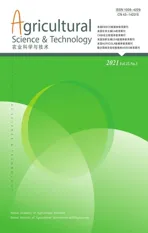Community Characteristics of Cardamine in Brassicaceae
2022-01-12HULongshengHUDieYANGYujieXUYaowenFEIYongjunCHENShuiyuan
HU Long-sheng , HU Die , YANG Yu-jie , XU Yao-wen , FEI Yong-jun *, CHEN Shui-yuan
1. College of Horticulture and Gardening, Yangtze University, Jingzhou 434025, PRC;
2. National R&D Center for Se-rich Agricultural Products Processing, Wuhan Polytechnic University, Wuhan 430000, PRC
Abstract [Objective] Further grasp the growth habit of Cardamine and cultivate a variety that meet the requirements of Cardamine hirsuta L.. [Method] A total of 17 sampling sites were set up to measure the geographic coordinates, altitude, slope direction, slope, canopy coverage, coverage, community structure and composition of the species of the community of Cardamine hirsuta in the sample plots. [Results]A total of 137 species, 62 families and 115 genera of vascular plants were found in the investigated communities. There were 111 species of herbaceous plants, whereas only 26 species of shrubs and trees. The dominant tree layers were Liquidambar formosana and Cinnamomum Camphora, the dominant shrub layers were Vitex Negundo and Rubus Lambertianus, and the dominant herb layers were Alopecurus aequalis and Imperata cylindrica. [Conclusion] Cardamine cardamine was suitable for growing in sunny, moist, ventilated fertile soil, as well as in areas with low density of slope, barren fields and on the banks of streams.
Key words Cardamine hirsute L.; Community characteristics; Plant community diversity
1. Introduction
Cardamine
hirsuta
L. belongs to the genusCardamine
in the Brassicaceae family and is annual or multi-year herbal plants widely distributed all over the world. In China, there are more than 40 species ofCardamine
. They are mainly distributed in Hebei, Shanxi, Shandong and various places in south of the Yangtze River.Cardamine
grows rapidly,has a long growth cycle, and the biomass per plant is large, reaching to 400 g/plant. It has a strong selenium enrichment ability. The selenium content of the whole plant, which is much higher than the selenium content of ordinary fruits and vegetables (≤ 0.01 μg/g), is basically stable at about 20 μg/g throughout the growth period.Cardamine
has an enrichment effect on heavy metals such as selenium, cadmium and lead.For this reason, not only canCardamine
be used as a wild vegetable for people to eat, it also can be used for economical and pollution-free remediation of areas contaminated with heavy metals.At present, the research onCardamine
is mostly focused on its enrichment effect on heavy metals such as selenium, cadmium, and organic arsenic,etc
.. There are few studies on the characteristics of theCardamine
community.Cardamine
hirsuta
L. in Qichun County, Hubei belongs toCardamine flexuosa
, which is distributed in different habitats such as hillsides, roadsides,streams, paddy fields, and ditches. In order to further grasp the growth habits ofCardamine
and cultivate a variety that are in line with human health standards,Cardamine
was observed collected and classified in this study.2. Overview of Research Area and Methods
2.1. Overview of research area
The survey site is located in Qichun County,Huanggang City, Hubei Province, spanning between 115°12′~115°56′ E and 29°59′~30°40′ N. It is located in the southeast of Hubei and at the southern foot of Dabie Mountain, The landform is hilly and mountainous, with lush woods and good vegetation.The area has a subtropical monsoon climate, with warm and humid temperatures throughout the year,an average temperature of 28°C and an average annual rainfall of 1 460 mm. Rainwater is mostly concentrated in July.
2.2. Investigation methods
Actual measurement method: SomeCardamine
communities were sparse and only scattered in the distribution area, which was convenient for direct counting of the target species. The researchers went deep into the field, where we investigated and verified the distribution area, population number and habitat changes of the target species through direct counting.We investigated the habitat type of the target species noting the name, species composition, canopy closure or coverage of the plant community habitat; the topography, altitude, slope, aspect, slope position, and soil type; man-made interference methods and degree of disturbance; protection statusetc
..Sampling method: In the survey, the plant community was divided into an tree layer (plants with height > 5 m), shrub layer (woody plants with height between 0.5 m and 5 m) and herb layer (herb plants with height < 0.5 m and vines) to conduct a statistical survey of the community. Based on the area and shape of the plot, we set up a plot with a size of 20 m×20 m and an area of 400 m, measured each tree in the plot,and recorded the species name, number, height, crown width, diameter at breast height, and diameter of each plant. At the same time, we set up 52 m×2 m shrub plots and 51 m×1 m herb plots at the four corners and center of each plot to record the species name, quantity,and height of shrubs and herbs and coverage.
2.3. Data processing and analysis
The calculation method of importance value was as follows:

The calculation formulas of community diversitywere as follows:

Simpson Index (Dominance Index):

S
represented number of species in the community;P
represented the importance value of speciesi
.3. Results and Analysis
3.1. Analysis of the composition of the plant species
Through a field survey of the plant community in theCardamine
distribution area of the survey site,it was found that there were 137 species of vascular plants near the community, belonging to 62 families and 115 genera. Among them, there were 26 species of woody plants, 22 genera and 20 families, accounting for 19.0% of the total species, 19.1% of the total genera, and 32.3% of the total family; 111 species of herbaceous plants, 93 genera, and 42 families,accounting for 81.0% of the total species. 80.9% of the total genera and 67.7% of the superfamily were shown in Table 1. Among them, the number of species in Gramineae, Compositae, Rosaceae, Polygonaceae,Caryophyllaceae, Scrophulariaceae, and Umbelliferae was 4 or more. Each of the other families had only 1 or 2 species, and the distribution was relatively even.Among them, there were 11 families, 11 genera and 11 species of trees; 9 families, 10 genera and 12 species of shrubs; 42 families, 93 genera and 111 species of herbs; 6 families, 10 genera and 10 species of vines.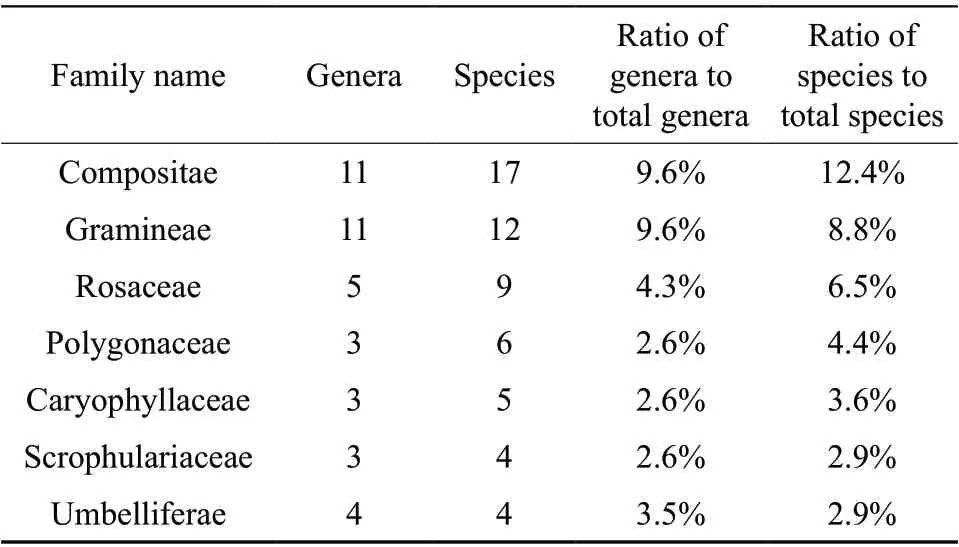
Table 1 The composition of the plant community
3.2. Analysis of the species richness and habitat characteristics of the community
Table 2 showed that the highest altitude of theCardamine
community under investigation was 189 m,the lowest altitude was 52 m. The No. 14 community had the highest species richness. 15 of the investigated communities were distributed on slopes, and 2 were distributed on flat places. Among the communities distributed on the sloping land, the slope direction was morning sun, accounting for 53.3% of the community; 4 were morning and half sun, accounting for 26.7% of the total community; 3 were morning and half shade, accounting for 20.0% of the total community. There were communities distributed on the upper, middle and lower slope: 7 were distributed on the middle of the slope, accounting for 46.7% of the total communities; followed by 3 on the middle and lower slopes, accounting for 20.0%. There were 2 in the middle, upper and lower communities, eachaccounting for 13.3%; there was 1 in the upper, middle and lower communities, each accounting for 6.7%.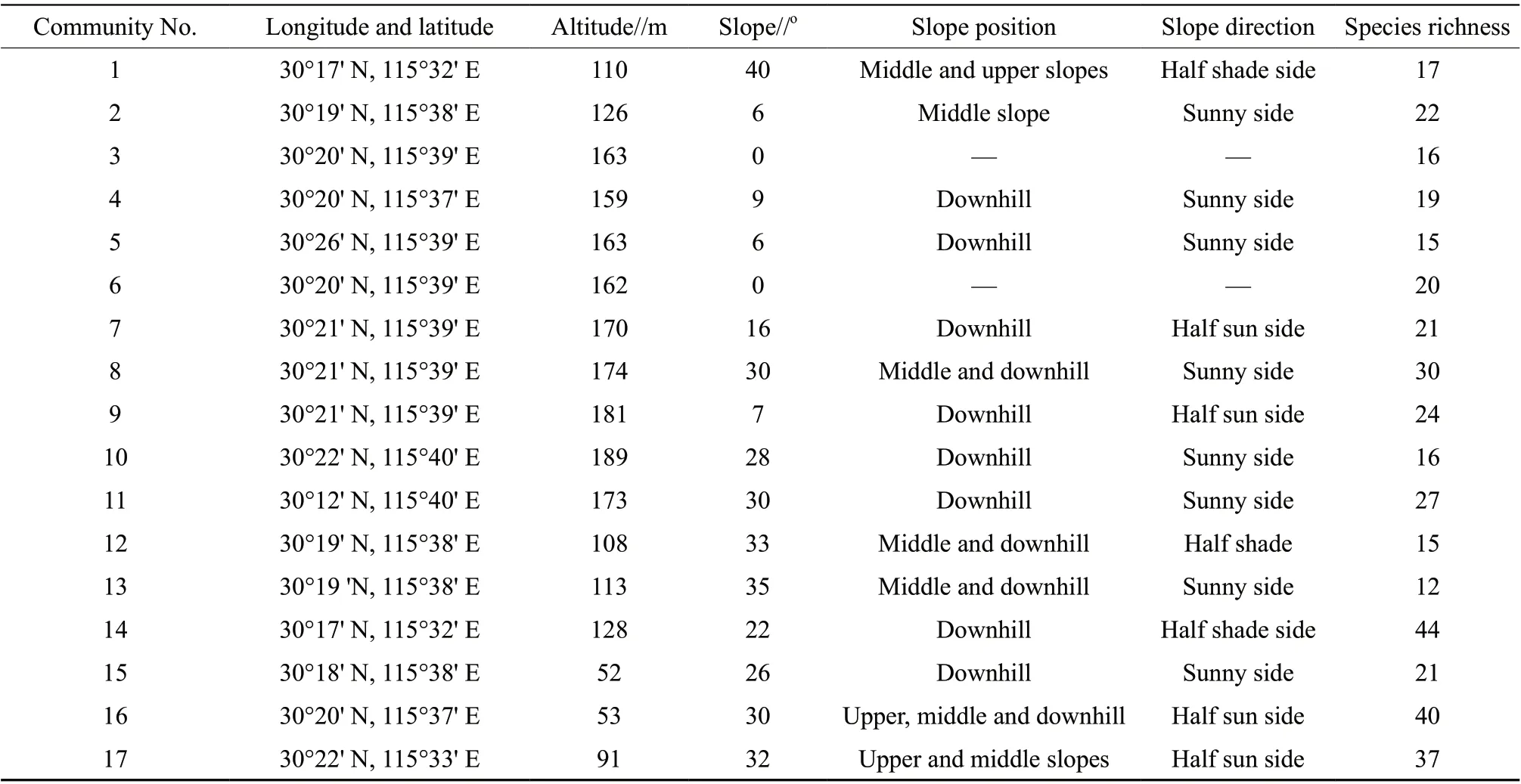
Table 2 The community species richness and habitat characteristics
The data analysis in Table 3 showed that in the tree layer of the survey community, the dominant species and the companion species that appeared most frequently wereLiquidambar formosana
andCinnamomum camphora
, both appearing in 4 sample squares. These accounted for 23.5% of the total. In the shrub layer, the dominant species and companion species wereVitex negundo
,Rubus lambertianus
, andBoehmeria nivea
, respectively.Vitex negundo
andBoehmeria nivea
appeared in 5 sample squares, the largest number of occurrences, accounting for 29.4%of the total.Rubus lambertianus
andBoehmeria nivea
both appeared in 3 sample squares, accounting for 17.6% of the total. In the herb layer, the dominant species and the companion species that appeared most frequently wereAlopecurus aequalis
,Imperata cylindrica
,Miscanthus floridulus
andDuchesnea indica
, all of which appeared in 3 sample squares,accounting for 17.6% of the total.3.3. Analysis of the structure of the plant community
Table 4 summarized the structure of 17 communities. Of these 17 communities, only 5 had an aquatic structure, because they were distributed beside streams and there were a few types of aquatic plants,such asAcorus calamus
andReynoutria japonica
.No. 3 and No. 11 only had an herbaceous layer, and No. 8, No. 13, and No. 15 had no arbor layer because they were distributed in barren fields or roadsides.The other communities, which were distributed on theroadside, slopes and barren fields, were dominated by the herbaceous layer. Although the structures of these communities were different, many of the species in their communities were the same and relatively simple.Species such asRubus lambertianus
,Alopecurus aequalis
,Duchesnea indica
and others appeared more frequently in each community, but the different ecological environments were more suitable for some species’ survival and more advantageous for some species’ growth. In the above community structure,the arbor layer did not have a clear advantage. There were 3 communities without an arbor layer, and the herb layer had a clear advantage.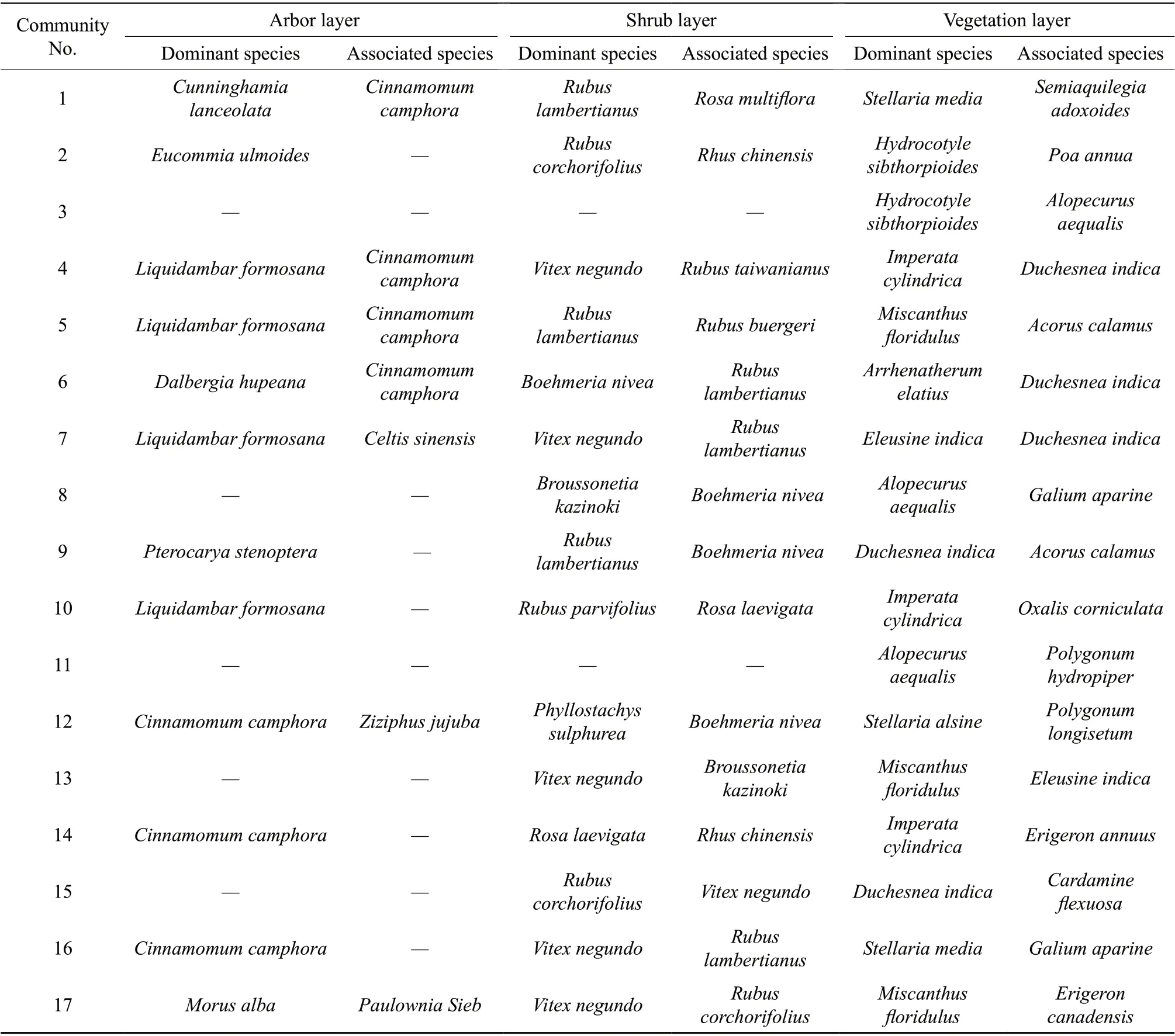
Table 3 Dominant and associated species of plants in different community layers

Table 4 The structure of the plant community
3.4. Analysis of the importance value of each species in the community
3.4.1. Analysis of the importance value of each species in the tree layer
The importance value of a plant species is an index by which to measure the importance of the species in the community. In Table 5, the species with importance values of the tree layer above 1.0 were counted. From the statistical data, the importance values of several tree species such asEucommia ulmoides
,Cunninghamia lanceolata
,Liquidambar formosana
andCinnamomum camphora
had the highest values in the tree layer, namely they played a relatively large role in the tree layer of theCardamine community
.Eucommia ulmoides
andCunninghamia lanceolata
are local economic tree species, which are planted by locals and distributed widely. The other tree species are local native tree species in Qichun County,and they can be seen everywhere, which is why these tree species have the highest importance value.3.4.2. Analysis of the importance value of each species in the shrub layer
Table 6 showed the distribution of species with importance values above 1.0 in the shrub layer. It can be analyzed that among the importance values of species in the shrub layer,Rubus lambertianus
,Rubus
corchorifolius
,Rubus parvifolius
,Vitex negundo
,Rosa multiflora
and other species had the highest importance values, and the Rosaceae plants occupied the majority of these shrubs, because Rosaceae has many species, strong adaptability, and wide distribution. Therefore, Rosaceae shrubs often appear in communities whereCardamine
is distributed.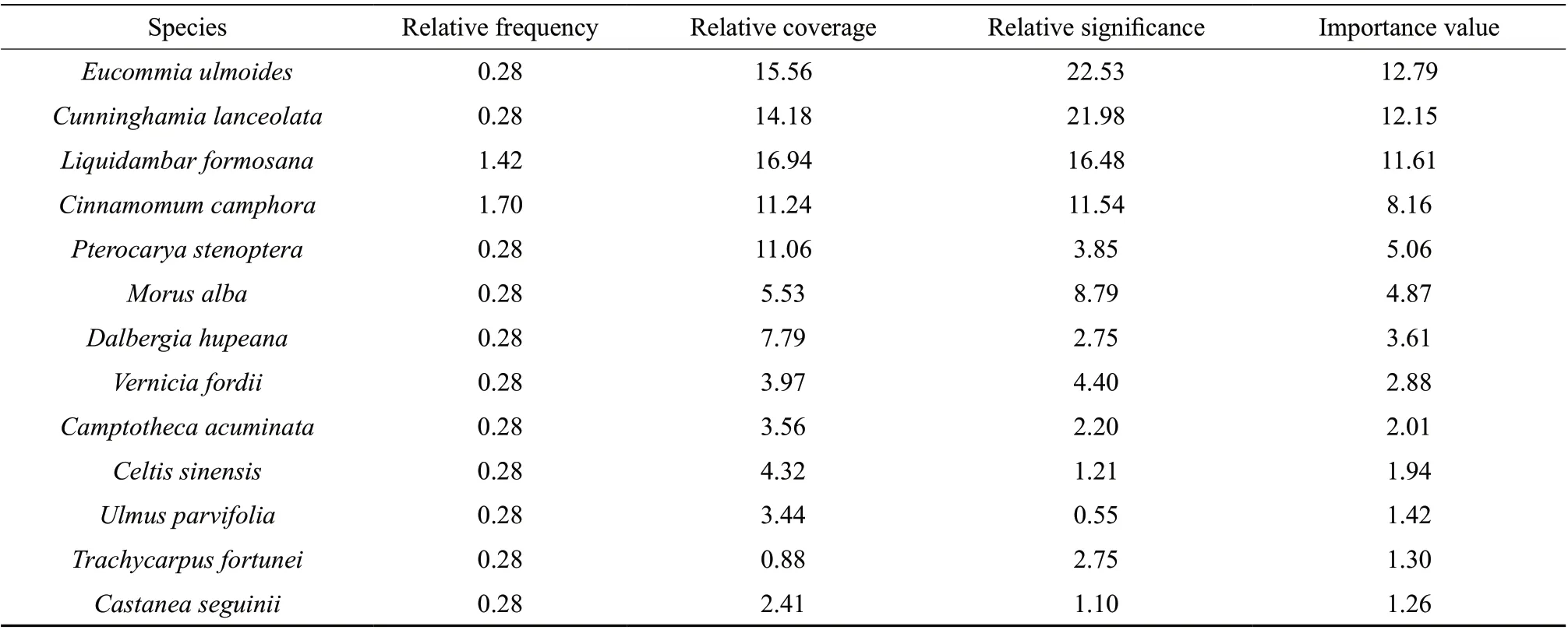
Table 5 The importance values of the main species in the tree layer
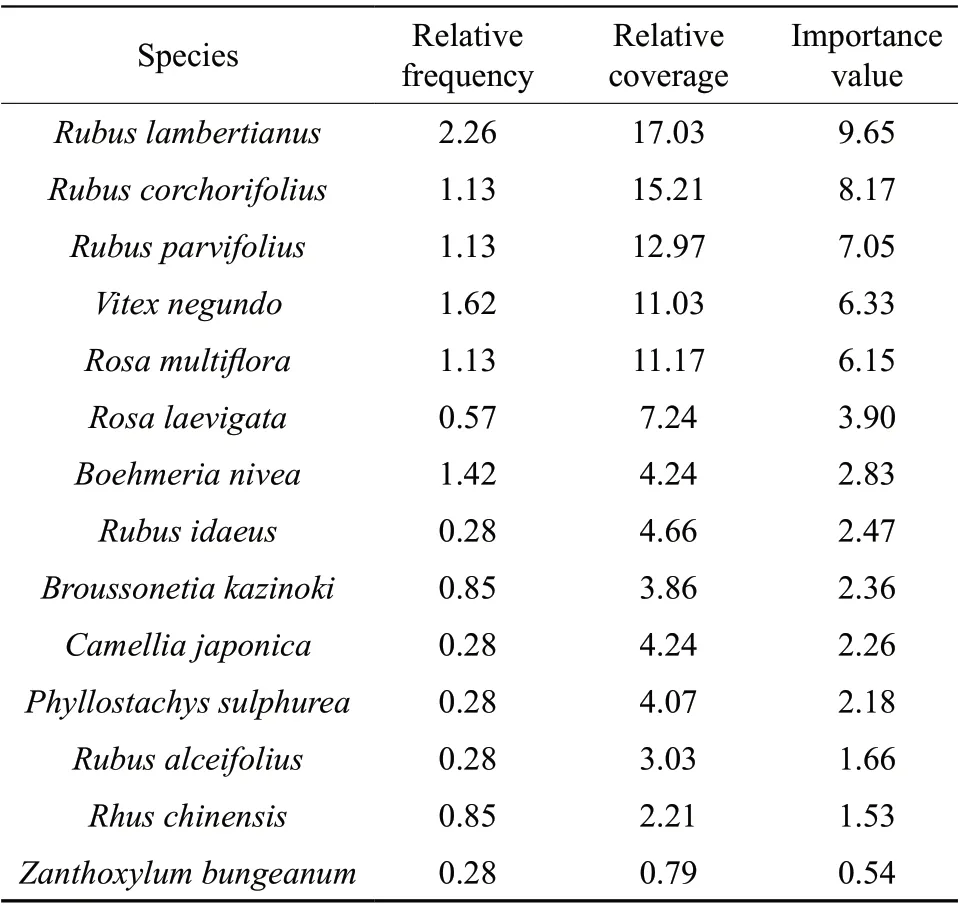
Table 6 The importance values of the main species in the shrub layer
3.4.3. Analysis of the importance value of each species in the herb layer
Table 7 showed the distribution of herbaceous species with importance values above 1.0. From the data in the table, we can see that the species with the higher importance values were the species such asAlopecurus aequalis
,Duchesnea indica
,Hydrocotyle sibthorpioides
,Imperata cylindrica
,Semiaquilegia adoxoides
,Agrimonia pilosa
,etc
..BecauseCardamine
communities are more distributed in paddy fields, ditches, roadsides and other places,Alopecurus aequalis
andHydrocotyle sibthorpioides
are often grown in paddy fields.Duchesnea indica
,Imperata cylindrica
,Semiaquilegia adoxoides
andAgrimonia pilosa
grow in humid ditches, roadsides,slopes,etc
., and are also very suitable for their growth in the environment of theCardamine
community,thereby the importance value of these species was also relatively high.3.5. Analysis of the species diversity of different Cardamine communities
The Simpson dominance index is a measure of the stability of the community. The higher the value,the higher the species diversity in the community. The Shannon-Wiener diversity index is an information measure of diversity and an indicator of uncertainty in measuring information. The Pielou evenness index is an index indicating the uniformity of species distribution. Table 8 showed the diversity of the community by measuring these three indicators in the community. It can be seen from Table 8, No.14 and No. 17 communities had the highest Simpson dominance index, which was 0.94; No. 2 and No. 5 communities had the lowest Simpson dominance index, which was 0.82. No. 14 had the highestShannon-Wiener diversity index, which was 3.23,and No. 15 had the lowest Shannon-Wiener diversity index, which was 1.96. No. 17 community had the highest Pielou index, which was 0.87, and No. 9 community had the lowest Pielou index, which was 0.66, followed by No. 8 and No. 5 communities,whose Pielou index were 0.71 and 0.72, respectively.The community diversity of No. 14, No. 16, and No. 17 communities were higher because they had better ecological conditions. The three communities of No.14, No.16 and No.17 were located in sunny and humid slopes with fertile soil and weak human disturbance, therefore, the indicators of their diversity were relatively high; and No. 5 and No. 9 were communities that grew near streams, The dominant species in the community were obvious and there were few species, hence the diversity was low. However,No. 2 community grew under artificially plantedEucommia ulmoides
, which had a lot of human interferences, hence the diversity was also low.
Table 7 The importance value of the main species in the herb layer

Table 8 The comparison of species diversity of the plant community
4. Conclusion and Discussion
In the analysis of the species composition of theCardamine
community in Qichun County, the herbaceous plants in theCardamine
community were obviously dominant, followed by shrubs and trees. The herb layer was dominated by Gramineae and Compositae, the shrub layer was dominated by Rosaceae, and the tree layer was dominated by Eucommiaceae. In the analysis of community species richness and community characteristics, there was no obvious correlation between species richness and altitude. Plant communities with species richness above 30 were distributed at slope of 22° to 32°.Among them,Cardamine
plant communities with high species abundance tended to be distributed on slopes with sunny, half-sun and half-shade areas,where human interference was weak and there were no obvious dominant species within the community.This was consistent with GAO Hui'sview that species richness was related to the degree of human disturbance, humidity, slope, and soil carbon and nitrogen content.In the analysis of the community structure,the vertical structure of theCardamine
community was relatively simple. The tree layer and shrub layer did not have obvious advantages. There were fewer aquatic plants and the herb layer had obvious advantages. There were 3 communities without trees and 2 communities with only herbs. LI Wei and ZHONG Yang’sstudy ofCardamine
in paddy fields on the shore of Hutou Lake in Hubei Province, which concluded that the vertical structure of theCardamine
community in paddy fields was simple, and the species composition was mainly herbaceous, mainly depending onAlopecurus aequalis
andNymphoides peltata
,Hydrocotyle sibthorpioides
,etc
., was basically consistent with the results of this study.In the analysis of the importance value of the species of each layer of plants, the main factor that caused the higher species importance value of the tree layer was human interference. The artificial planting ofEucommia ulmoides
andCunninghamia lanceolata
and other tree species made their importance values higher, which was similar to ZHANG G F. The conclusions drawn in the study of wild Davidia involucrata plant communities were consistent, that human activities will make certain tree species high in importance. The main factor affecting the importance value of species in the shrub layer and herb layer was moisture. LEI R Hfound that the importance value of species in the community increased with the elevation in the study of the wildOsmanthus fragrans
community in Xiangxi. The trend was not necessarily related to the results of this article. The reason for this difference was that theCardamine
communities investigated in this study were distributed in places with small altitude differences, and there was no obvious linear relationship with altitude factors.In the analysis ofCardamine
community diversity, higher species diversity, richness, uniformity and lower ecological dominance meant that the higher the diversity, the more stable the community, and the stronger the resistance to external disturbances and adverse environmental conditions. When the community was near a stream, human disturbance was strong, and the dominant species occupied a large living space, the community’s species diversity would decrease. When the community’s habitat had fertile soil, and it was humid and sunny, there were no particularly obvious dominant species and the degree of human disturbance was weak, the community species diversity indicators were relatively high. JIANG X Let al
., in their research on the plant community diversity in Laoshan, concluded that plant community diversity was closely related to the community’s moisture, slope aspect, and soil phosphorus content, which was consistent with the conclusions in this article.杂志排行
Agricultural Science & Technology的其它文章
- Effects of Different Soil Amendments on the Yield of Salt-alkali Tolerant Rice
- Effects of 4 Types of Remediation Agents on Reducing Cd Contents in Soil and Rice on Cd-contaminated Farmland
- Efficient Extraction of Tea Saponin from Tea Seed Meals by 60Co γ-Irradiation
- Effects of Boron Application on Growth and Quality of Flue-cured Tobacco NC297 under Different Potassium Supply Levels
- Protective Effect of Immaturue Bitter Orange (Citrus aurantium L.) Flavonoids Extracts on PC12 Cell Injury Induced by 6-Hydroxydopamine
- Characterization of Specific Spoilage Bacteria and Volatile Flavor Compounds of Flavored Crayfish
